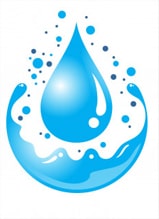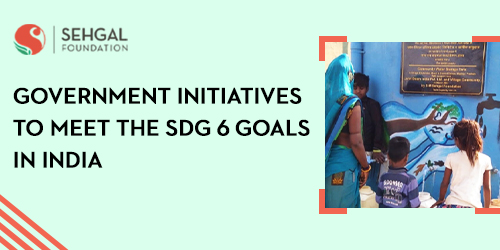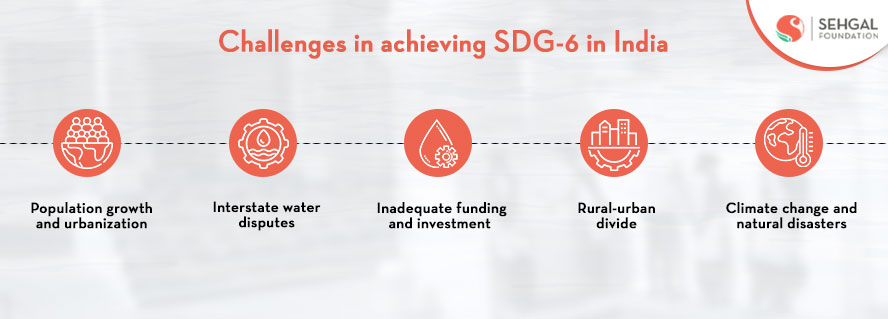-
Government Initiatives To Meet The SDG 6 Goals In India
- By admin
- 23 Jun 2023

- About Us
- Our Work
- Knowledge Center
- Dialogue
- Donate
Table of Contents
- Introduction
- Challenges
- Government Initiatives
- S M Sehgal Foundation & Its Contributions
SDG 6, which focuses on inclusive access to clean water and sanitation, holds immense significance due to its close association with various aspects. It directly impacts health by addressing water-borne infections and hygiene-related diseases, contributes to food security through access to irrigation facilities, and supports livelihoods for millions, particularly in developing nations. SDG 6 should be viewed as a fundamental human right and also as an indicator of a country’s human capital functioning. Today, ensuring both equitable distribution and sustainable demand management of water resources is a shared developmental agenda. Challenges such as water scarcity, flooding, and inadequate wastewater management hinder sustainable socio-economic progress.
Since India’s independence in 1947, the nation has remained committed to providing water and sanitation services to its citizens. Through programs supported by UNICEF, India has not only delivered essential services but also imparted long-term training, and technical assistance, and encouraged innovation by leveraging international expertise. These initiatives have actively involved local communities and private sectors, fostering a comprehensive approach to address water and sanitation challenges.
The Challenges In Achieving SDG-6 In India
Addressing the following challenges requires a multi-dimensional approach, involving policy reforms, institutional capacity building, community participation, technological innovations, and international cooperation. Collaborative efforts from governments, civil society organizations, private sector entities, and individuals are essential for achieving SDG 6 and ensuring sustainable access to clean water and sanitation for all in India.
Population growth and urbanization – India’s rapidly growing population and increasing urbanization put immense pressure on water resources and sanitation infrastructure. Managing the water and sanitation needs of a large and expanding population poses significant challenges.
Interstate water disputes – Water sharing and management disputes between different states within India can lead to conflicts and hinder effective water governance. Resolving these disputes and ensuring equitable water allocation is crucial for achieving SDG 6.
Inadequate funding and investment – Insufficient funding for water and sanitation infrastructure development, operation, and maintenance poses a challenge. Mobilizing adequate financial resources and attracting investments in the water sector is essential for sustainable progress.
Rural-urban divide – Disparities in access to clean water and sanitation are prevalent between rural and urban areas. Rural regions often face greater challenges in terms of infrastructure development and service delivery.
Climate change and natural disasters – Increasing climate variability, including erratic rainfall patterns and extreme weather events, affect water availability and quality. Floods, droughts, and cyclones further disrupt water sources and infrastructure.
With the country facing so many challenges, what is the government doing to achieve SDG 6?
Initiatives By The Indian Government To Meet SDG 6.
The Indian government has implemented several initiatives to work towards achieving SDG 6, which focuses on ensuring the availability and sustainable management of water and sanitation for all. These initiatives, among others, reflect the Indian government’s commitment to achieving SDG 6 targets and addressing water and sanitation challenges. The government continues to implement and strengthen these programs to ensure universal access to safe water and sanitation in the country. Some key initiatives include –
Swachh Bharat Mission (Clean India Mission) – Launched in 2014, this nationwide campaign aims to eliminate open defecation, promote cleanliness, and improve solid waste management. It focuses on constructing toilets, promoting behavior change, and ensuring access to sanitation facilities.
Jal Jeevan Mission – Launched in 2019, this mission aims to provide piped water supply to every household in rural areas of India by 2024. It focuses on water source development, infrastructure creation, capacity building, and community participation.
National Rural Drinking Water Program (NRDWP) – This program focuses on providing safe drinking water to rural areas. It aims to ensure the sustainability of water supply schemes, water quality testing, and community-based management of water resources.
Atal Bhujal Yojana (ABHY) – This scheme was launched in 2018 with the objective of sustainable management of groundwater resources. It focuses on community participation, demand-side management, and strengthening institutional frameworks for groundwater management.
National Urban Sanitation Policy (NUSP) – This policy aims to ensure sanitation and waste management in urban areas. It focuses on promoting sanitation practices, constructing toilets, and implementing solid waste management systems.
National Water Mission (NWM) – Under the NWM, the government works towards sustainable water management, conservation, and reducing water demand. It focuses on enhancing water use efficiency, promoting water-saving technologies, and increasing public awareness.
The government collaborates with reputed NGOs that go into the rural areas and play a crucial role in the campaigning activities to generate awareness regarding these issues, as well as government initiatives to resolve those issues. One such NGO is the –
S M Sehgal Foundation
S M Sehgal Foundation – a sustainable rural development NGO in India, with its extensive experience since 1999, is dedicated to enhancing the quality of life in rural communities across India. The foundation’s strong presence in twelve states focuses on collective action and participatory approaches to address key rural development challenges. Through research, impact assessment, interactive dialogue, and community engagement, the foundation empowers communities, provides training opportunities, and strives for sustainable outcomes.
The S M Sehgal Foundation operates with a philosophy that emphasizes flexibility while staying firmly committed to its core values and guiding principles of integrity, excellence, professionalism, optimism, and respect. Recognizing the potential of rural communities, the foundation believes that with the right support from civil society organizations and the government, communities can develop their own vision for development and translate their awareness into meaningful action.
Let’s read further and learn more about their contributions to rural India.
A POND REJUVENATION IN ALWAR
In a commendable initiative supported by CSR, S M Sehgal Foundation embarked on a transformative project to revitalize a village pond in Behror block, Alwar district, Rajasthan, in January 2021. The pond faced multiple challenges as its water collection area was limited and overgrown with thorny keekar bushes. Consequently, significant amounts of rainwater cascaded forcefully from the Aravalli hills, flowing through the village without being harnessed, and causing damage to crops in its path.
Recognizing the need for action, the determined villagers and the dedicated project team united their efforts to bring about a comprehensive rejuvenation of the pond. They meticulously worked towards expanding the catchment area, undertaking desilting activities, and strategically redirecting the water flow towards the pond. These concerted actions resulted in a remarkable transformation. Instead of being squandered, the rainwater that once went to waste now finds its rightful place in the village pond.
The impact of this rejuvenation endeavor has been truly remarkable. During the monsoon season of 2021, the revitalized pond, initially designed to store 4.6 million liters of water, successfully accumulated rainwater on seven separate occasions. Its enhanced water storage capacity, now increased to an impressive 16.8 million liters, has provided a vital reservoir for capturing and preserving rainwater. However, the current absence of water in the pond is a testament to its critical role in recharging the groundwater levels beneath.
The positive outcomes extend beyond the immediate vicinity of the pond. The increased groundwater recharge has already begun to elevate the water levels of nearby wells, ensuring a sustainable supply for irrigating crops. It is anticipated that these water levels will further rise by ten to fifteen feet, offering promising prospects for agricultural productivity. Moreover, the thriving pond ecosystem, now restored to its natural state, provides a conducive environment for vibrant plant life and contributes to overall environmental health.
The transformation of the village pond in Behror stands as a testament to the power of collective action and the commitment of the S M Sehgal Foundation to sustainable development. Through this endeavor, not only has water wastage been curbed, but the entire community has witnessed the invaluable benefits of efficient water management. The success of this project serves as an inspiring example for other regions, demonstrating the potential for holistic rejuvenation efforts to ensure a greener, more water-secure future for rural India.
RECHARGE WELL IN A GOVERNMENT SCHOOL, KHERLA
In a collaborative effort between S M Sehgal Foundation and Rio Tinto, an innovative and eco-friendly solution was devised to address waterlogging and groundwater depletion in a government senior secondary school, in Kherla. The implementation of a recharge well proved to be a cost-effective and sustainable approach. By allowing rainwater to infiltrate the ground through the recharge well, approximately 1.5 million liters of water per year are recharged, effectively tackling both issues simultaneously.
Thanks to installing the recharge well, the school campus no longer suffers from waterlogging. The rainwater effortlessly permeates the ground through the well, ensuring a dry and functional environment for students and staff. Moreover, this ingenious solution contributes to replenishing the water table, combatting the problem of rapid water depletion. As a result, there is increased availability of water for agricultural purposes and consumption, providing much-needed relief to the community.
Stay connected
-
Contact us
-
Sign up for
newsletter



 Contact us
Contact us  Sign up for
Sign up for